How Will AI Transform Recruiting?
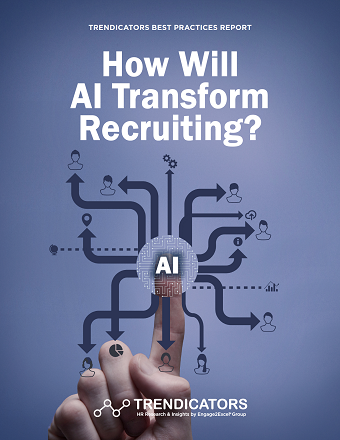
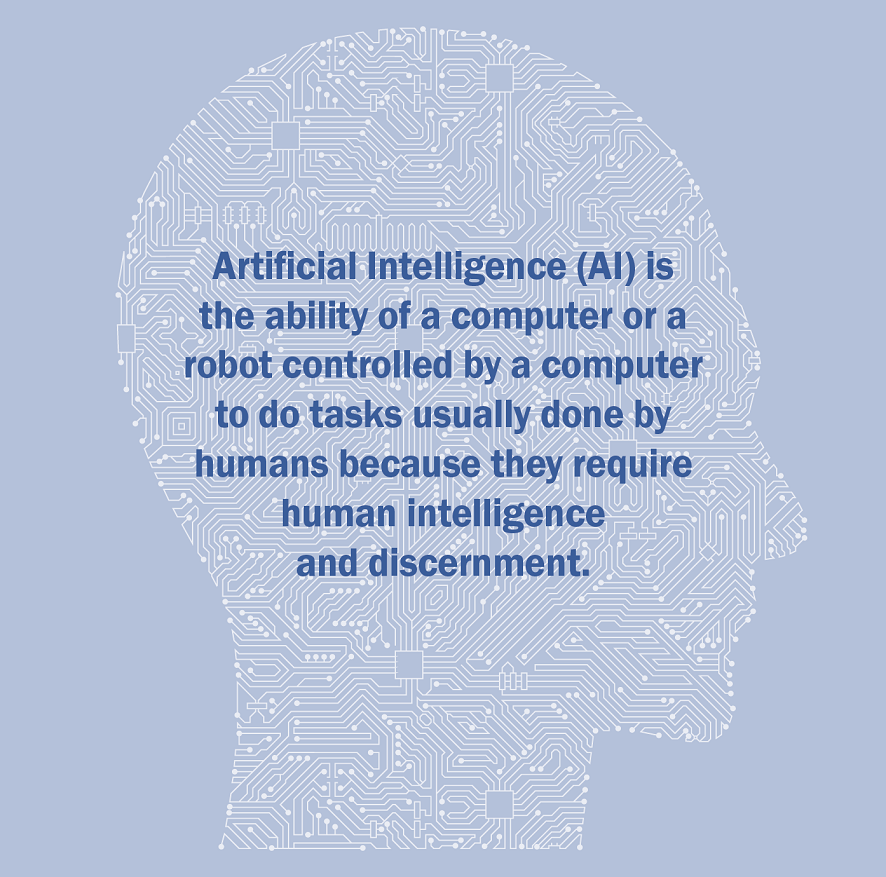
Introduction
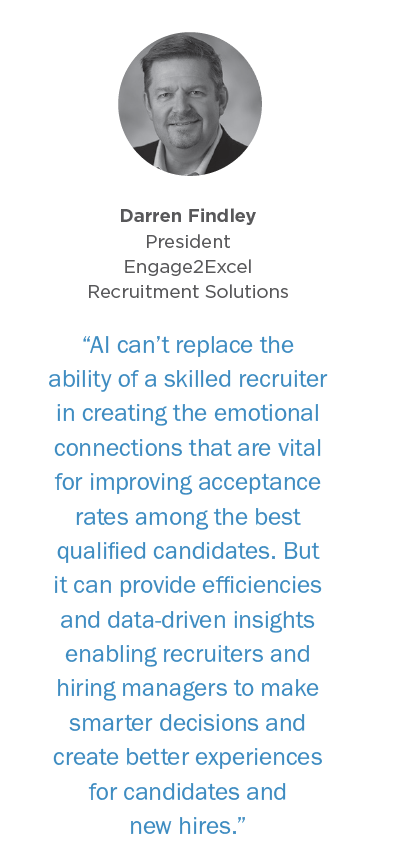 When reviewing analyst reports that assess which organizations stand to gain the most from the integration of AI technology into their daily operations, you find that recruiting often doesn’t make it into the top five. Instead, customer service, marketing, sales, accounting and finance, research and development and IT operations are the departments currently benefiting most from investments in AI. The irony is that talent acquisition is the engine that drives innovation across all departments.
When reviewing analyst reports that assess which organizations stand to gain the most from the integration of AI technology into their daily operations, you find that recruiting often doesn’t make it into the top five. Instead, customer service, marketing, sales, accounting and finance, research and development and IT operations are the departments currently benefiting most from investments in AI. The irony is that talent acquisition is the engine that drives innovation across all departments.
HR departments have been using machine learning, robotic process automation and intelligent algorithms for years to speed the process of screening resumes and applications. Today, AI enables recruiters to use the power of data to make better decisions. The use of AI technology has come under much scrutiny in recent years over data privacy concerns and the risk of perpetuating and amplifying biases and discrimination. Despite these concerns, investment in AI-enabled technologies is expected to grow nearly three-fold over the next seven years.*
In this eBook, we provide brief overviews of how AI-enabled tools and platforms can assist in writing job descriptions, sourcing and screening candidates, engaging candidates throughout the hiring process, facilitating interviews and improving onboarding experiences. Our objective is to provide HR and recruitment leaders who have yet to deploy these technologies with a guide to getting started with their journey. The question isn’t whether AI will transform recruiting or even when it will happen; it’s already underway.
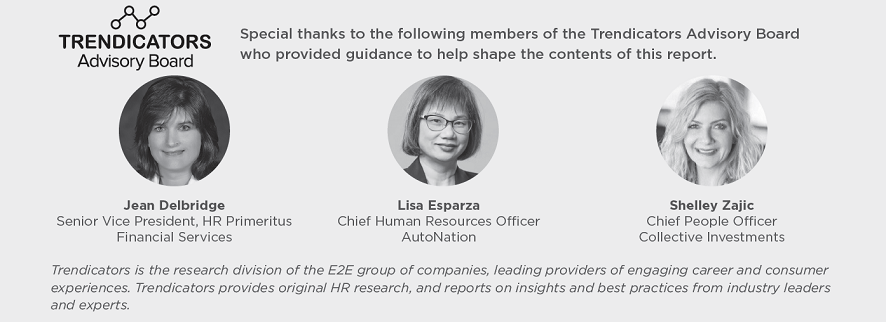
*SOURCE: Grand View Research.
Download
 hbspt.cta.load(123973, '3c5e2ea9-669b-4c2c-b263-bd797375779f', {"useNewLoader":"true","region":"na1"});
hbspt.cta.load(123973, '3c5e2ea9-669b-4c2c-b263-bd797375779f', {"useNewLoader":"true","region":"na1"});
Writing Job Descriptions
Looking for a way to improve the quality of your job descriptions while ensuring that the right keywords are included to attract the most qualified responses? Generative AI is an indispensable tool that saves time by using natural language processing to create job descriptions that are more accurate, concise, inclusive and keyword optimized. This is a huge time saver for hiring managers and recruiters. AI tools expressly designed for recruiting include templates and can also help overcome unintentional bias.
Is the first AI-generated draft too formal? Tell the tool to make it less formal and get a new draft in seconds. However, don’t expect AI to add the unique details that differentiate your company, culture and career opportunities. In all cases, AI should only be used to get to a first draft, then refined by an expert recruiter.
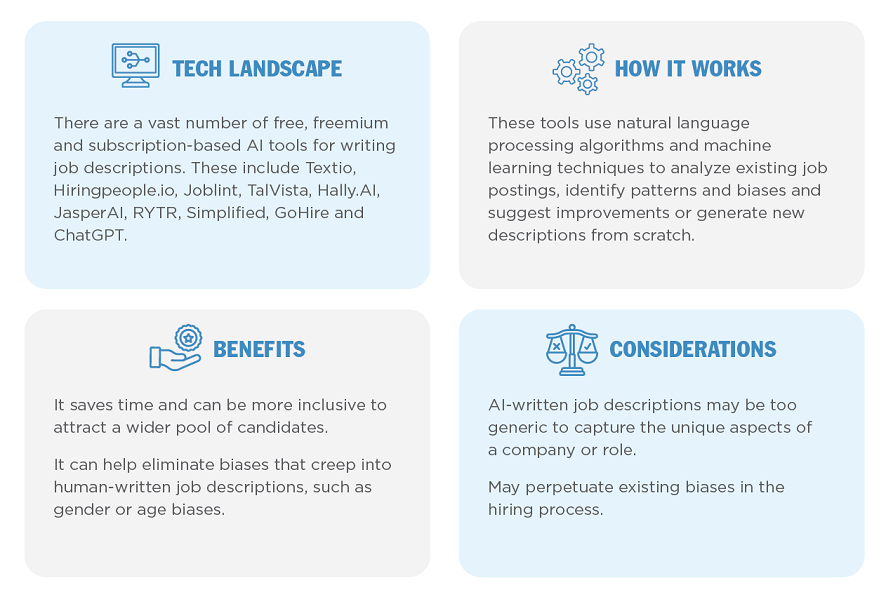
Download
 hbspt.cta.load(123973, '3c5e2ea9-669b-4c2c-b263-bd797375779f', {"useNewLoader":"true","region":"na1"});
hbspt.cta.load(123973, '3c5e2ea9-669b-4c2c-b263-bd797375779f', {"useNewLoader":"true","region":"na1"});
Candidate Sourcing
Candidate sourcing tools are software applications recruiters and hiring managers use to find, identify and engage with talent for open positions in their organizations. The platforms aggregate data from various sources, including job boards, social media platforms and professional networks, to create comprehensive candidate profiles. Intelligent algorithms analyze these profiles and provide recruiters with insights and recommendations. Recruiters can search for specific skill sets, experience levels, and qualifications, ensuring they find the best fit for their company. Some applicant tracking systems (ATS), recruitment automation and CRM platforms include candidate sourcing tools.
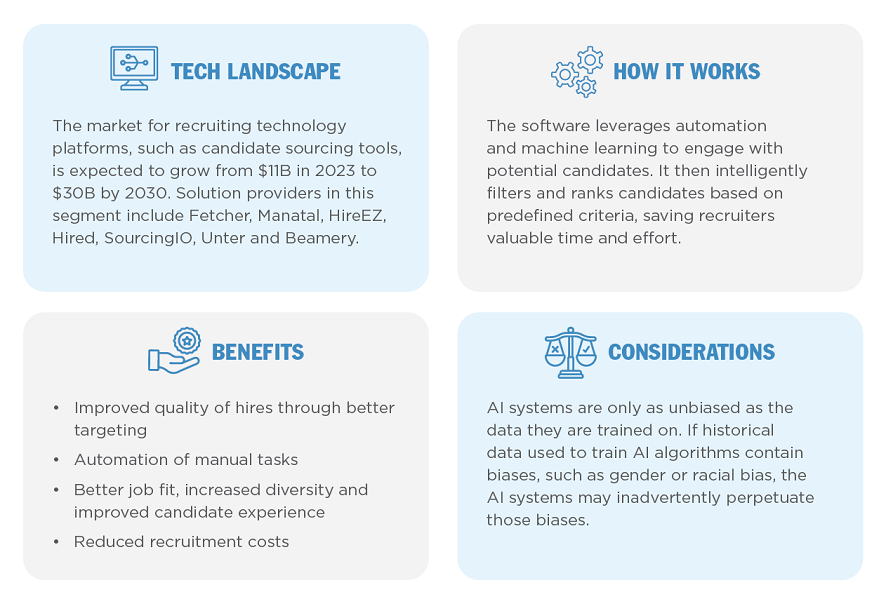
Download
 hbspt.cta.load(123973, '3c5e2ea9-669b-4c2c-b263-bd797375779f', {"useNewLoader":"true","region":"na1"});
hbspt.cta.load(123973, '3c5e2ea9-669b-4c2c-b263-bd797375779f', {"useNewLoader":"true","region":"na1"});
Recruiting Chatbots
Recruiting chatbots are automated messaging tools that engage with and help filter candidates through your career site and into the applicant funnel. Chatbots can answer commonly asked questions about the application process, benefits, work-from-home policies and next steps in the hiring process. An AI chatbot responds to questions in natural language as if it were a real person. Responses are determined by pre-programmed scripts and machine learning algorithms. When asked a question, the chatbot will answer using the knowledge database that is currently available to it. As the bot learns from its interactions with users, it continues to improve. The chatbot identifies a query’s language, context and intent and then reacts accordingly. Sentiment analysis makes bots even more powerful by understanding the emotion in candidate messages.
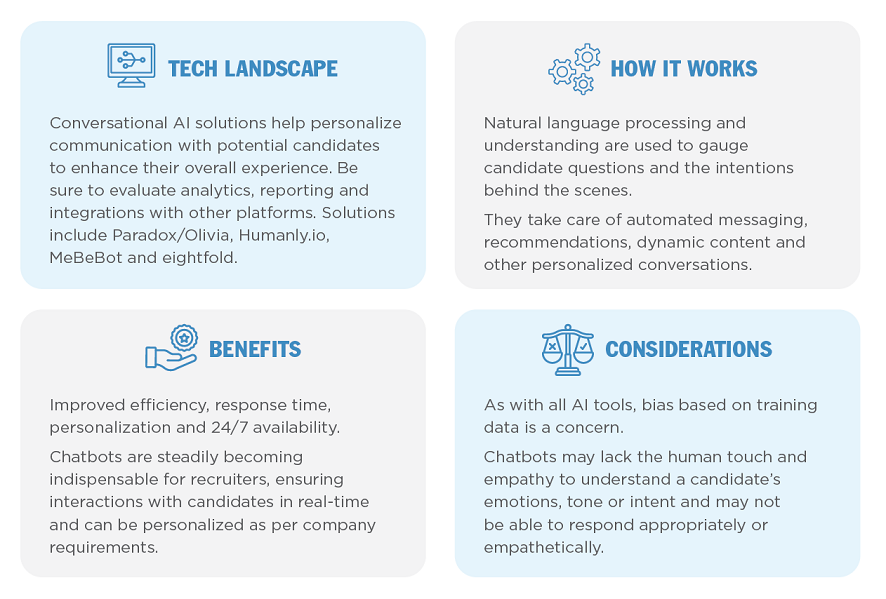
Download
 hbspt.cta.load(123973, '3c5e2ea9-669b-4c2c-b263-bd797375779f', {"useNewLoader":"true","region":"na1"});
hbspt.cta.load(123973, '3c5e2ea9-669b-4c2c-b263-bd797375779f', {"useNewLoader":"true","region":"na1"});
AI-Assisted Interviewing
While companies have long used machine learning, robotic process automation and AI to source candidates and screen resumes and applications, companies are now starting to use these technologies as part of the interview process itself. AI Interviewing platforms aim to reduce the time and effort humans devote to the hiring process. There are two main types of AI interview platforms. AI assessment platforms analyze video interviews to assess candidates based on verbal and non-verbal cues. AI chatbot interview platforms facilitate the interview process by guiding candidates through a series of questions and tasks. Common features of these platforms include automated question generation, real-time analysis of candidate responses and stack-ranking of candidates. Some platforms use predictive analytics to continuously improve hiring success.
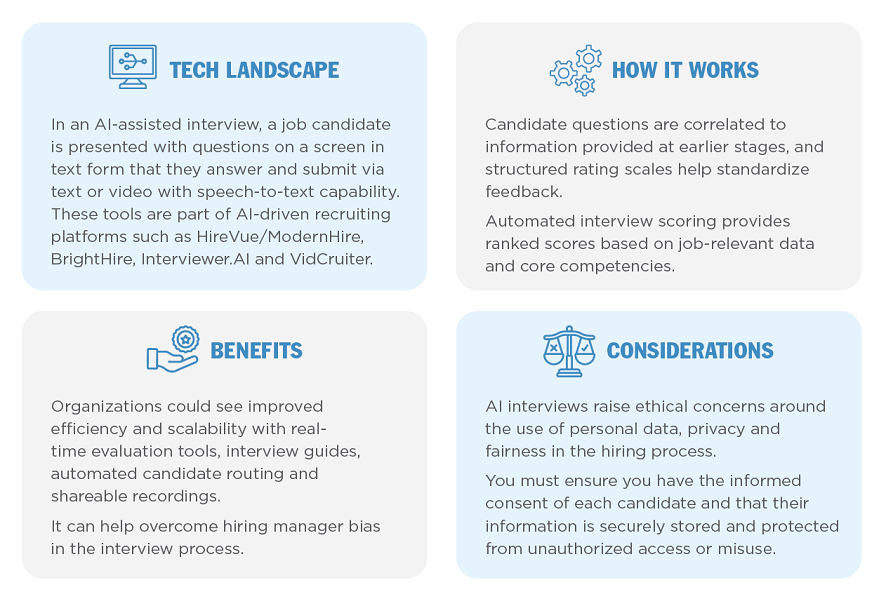
Download
 hbspt.cta.load(123973, '3c5e2ea9-669b-4c2c-b263-bd797375779f', {"useNewLoader":"true","region":"na1"});
hbspt.cta.load(123973, '3c5e2ea9-669b-4c2c-b263-bd797375779f', {"useNewLoader":"true","region":"na1"});
Employee Onboarding
When employee onboarding processes are slow and inefficient, it leads to early attrition. Our 2023 Job Seeker Survey revealed that 70% of respondents said the first day of their onboarding experience is highly likely or likely to affect their decision to stay more than a month. AI-enabled onboarding platforms can create better employee experiences to increase retention and reduce time to productivity. Leading platforms help reduce administrative tasks, track employee progress throughout onboarding, and integrate with learning management systems for training. These platforms can “listen” for a predefined business event and trigger actions across applications, databases and teams. AI-enabled onboarding platforms can also provision software, schedule orientation meetings, pair new hires with buddies and collect feedback on the onboarding process.
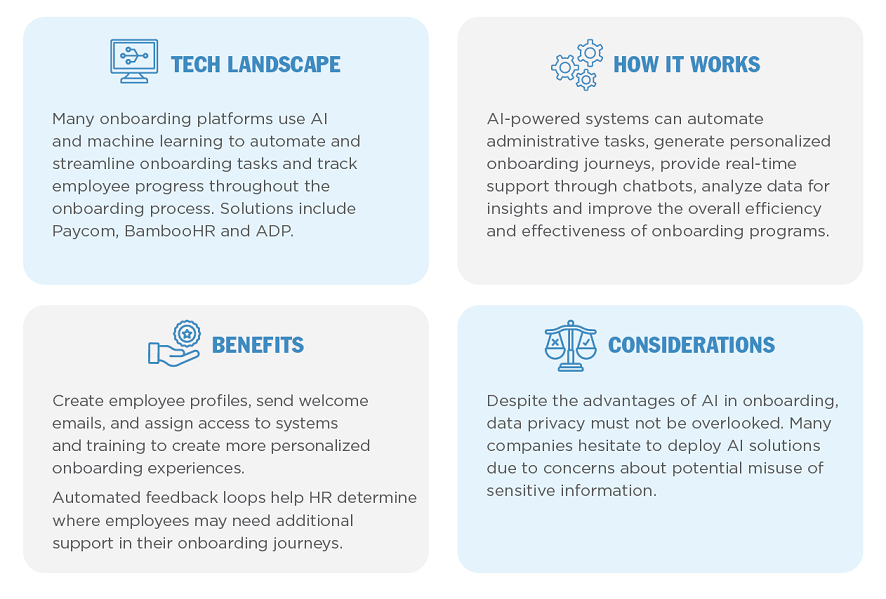
Download
 hbspt.cta.load(123973, '3c5e2ea9-669b-4c2c-b263-bd797375779f', {"useNewLoader":"true","region":"na1"});
hbspt.cta.load(123973, '3c5e2ea9-669b-4c2c-b263-bd797375779f', {"useNewLoader":"true","region":"na1"});
Looking Forward
Consumers have been at the forefront of adopting revolutionary technology for more than five decades. Consumer popularity has helped fuel widespread organizational use of personal computers, the internet, smartphones and social media. Enterprise adoption of AI is following a different path because of massive investment from tech companies, large enterprises, venture capital and private equity firms. Generative AI’s ability to increase efficiencies, reduce costs and improve innovation and customer experiences profoundly reshapes how companies operate and create value. But individuals’ use of AI tools is also growing exponentially on the largest platforms, including ChatGPT, Google Bard, Claude and Jasper AI. And it’s hard to find a cloud-based platform for consumers that hasn’t already integrated AI tools.
The Need for Regulation: The recent gathering of tech visionaries on Capitol Hill signals a first step in establishing guardrails for AI governance to curtail the spread of misinformation, safeguard critical infrastructure, protect personal data and ultimately prevent a semi-apocalyptic scenario—intelligent machines outperforming humans. These much-needed discussions will eventually lead to policies and regulations that usher in a safer AI-enabled world. But this is unlikely to slow the unprecedented advance of AI technology. AI is here to stay. Statistica estimates that the global market for AI will expand at a remarkable compound annual growth rate of over 37% between 2023 and 2030.
Use of AI by Knowledge Workers: Regardless of your organization’s posture for integrating AI into daily operations, it’s already happening at the personal level. For example, knowledge workers use personal AI tools to record and summarize meetings and action items and create first-draft content, graphics and imagery for marketing, white papers, proposals, presentations and social media. AI tools accelerate software development for coders and help turn side hustles into full-time gigs for millions worldwide.
Take the Plunge: If you’re a decision-maker or an influencer of your organization’s adoption of AI in HR and recruiting but have yet to experience the power of AI in your work or personal pursuits, it’s time to take the plunge. You’ll find that, unlike other technologies with a steep learning curve, AI tools are easy to use and inherently intuitive, responding to instructions and prompts in the same way a person would. A good reference for starting or expanding your personal AI journey is a Forbes article from February 2023: “Beyond ChatGPT: 14 Mind-Blowing AI Tools Everyone Should Be Trying Out Now.” If you’re on TikTok, just search for “Artificial Intelligence 2023” and prepare to be inundated.
The information presented in this eBook is based on research compiled from online sources and is intended only as a primer for organizations to use to learn more about AI-enabled recruiting tools and platforms. Engage2Excel Group and its Trendicators research division do not endorse or recommend any of the providers listed in this publication. Before making any purchase decisions regarding AI platforms or tools or implementing them within your organization, it is essential to engage key stakeholders from the IT, legal, finance, procurement and compliance teams.
Download
 hbspt.cta.load(123973, '3c5e2ea9-669b-4c2c-b263-bd797375779f', {"useNewLoader":"true","region":"na1"});
hbspt.cta.load(123973, '3c5e2ea9-669b-4c2c-b263-bd797375779f', {"useNewLoader":"true","region":"na1"});